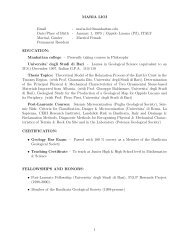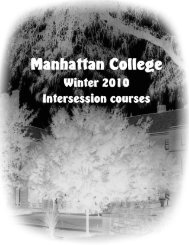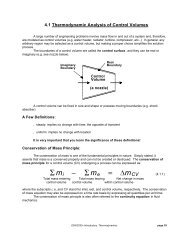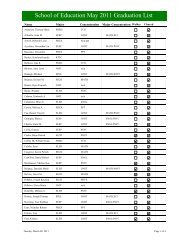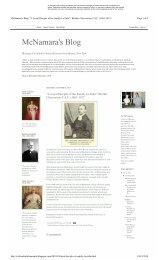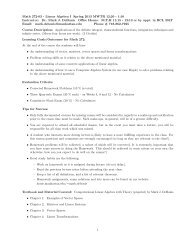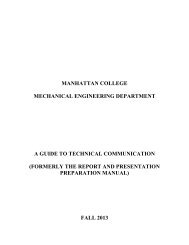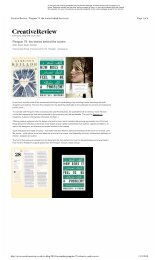Flexibility in timing of molting of fiddler crab ... - Inter Research
Flexibility in timing of molting of fiddler crab ... - Inter Research
Flexibility in timing of molting of fiddler crab ... - Inter Research
Create successful ePaper yourself
Turn your PDF publications into a flip-book with our unique Google optimized e-Paper software.
56 Mar Ecol Prog Ser 146: 55-60, 1997We have developed and tested a method to placeequal numbers <strong>of</strong> sibl~ng, laboratory-reared larvae <strong>in</strong>tothe field, enclosed <strong>in</strong> mesh cages, for exposure to differenttypes <strong>of</strong> potential habitat cues. The methodfacilitates easy retrieval <strong>of</strong> cages and subsequent exam<strong>in</strong>ation<strong>of</strong> enclosed animals. Other advantages <strong>of</strong>our method are that the larvae have had no prior exposureto natural cues <strong>in</strong> the field, they have been rearedunder identical conditions, they are <strong>of</strong> known ages andcompetent to settle and metamorphose, and we do nothave to rely on chance transport <strong>of</strong> larvae to experimentalsubstrata. In addition, the responses <strong>of</strong> larvae tocomplex cues <strong>in</strong> the field can be compared directlywith those <strong>of</strong> larvae exposed to s<strong>in</strong>gle cues <strong>in</strong> the laboratory.The present study exam<strong>in</strong>ed the effects <strong>of</strong> 2 potentialhabitat cues on tim<strong>in</strong>g <strong>of</strong> molt<strong>in</strong>g <strong>of</strong> Uca pugnax megalopae<strong>in</strong> the field. The first cue was the natural seawateroverly<strong>in</strong>g the surface <strong>of</strong> a salt mdrsh <strong>in</strong>habited by Lipugnax (represent<strong>in</strong>g waterborne cues). The secondcue was the sedirnents freshly collected from the marshsurface (= benthic cues). Although both cues ~ndlviduallyaffected the tim<strong>in</strong>g <strong>of</strong> molt<strong>in</strong>g, the greatest responseto these complex habitat cues occurred whenwaterborne and benthic cues were comb<strong>in</strong>ed.MATERIALS AND METHODSLarval culture. Larvae used <strong>in</strong> the experiments werereleased by ovigerous female Uca pugnax collectedfrom the Slocums River estuary <strong>in</strong> S. Dartmouth, Massachusetts,USA (sal<strong>in</strong>ity approx. 30) <strong>in</strong> June 1995.Additional larvae were obta<strong>in</strong>ed from <strong>crab</strong>s that werema<strong>in</strong>ta<strong>in</strong>ed <strong>in</strong> the laboratory and periodically checkedfor the presence <strong>of</strong> eggs. Ovigerous <strong>crab</strong>s were placed<strong>in</strong>dividually <strong>in</strong> 11.5 cm glass culture dishes with-200 m1 filtered (0.45 pm) seawater diluted with deionizedwater to a sal<strong>in</strong>ity <strong>of</strong> 25 (= FSW), to which theantibiotics sodium penicill<strong>in</strong> G (21.9 mg I-') and streptomyc<strong>in</strong>sulfate (36.5 mg 1-l) were added. Each morn<strong>in</strong>gthe dishes were checked for the presence <strong>of</strong> larvae.If larvae had not hatched, the ovigerous females weretransferred to a clean bowl with fresh FSW and antibiotics.The <strong>crab</strong>s were not fed.Newly released sibl<strong>in</strong>g zoeae were placed <strong>in</strong> groups<strong>of</strong> -40 <strong>in</strong> each <strong>of</strong> 3 or 4 culture dishes (diam. 11.5 cm).Each dish conta<strong>in</strong>ed -175 m1 <strong>of</strong> FSW and ant~blotics.The zoeae were <strong>of</strong>fered the rotifer Brachionuspllcatilisand newly hatched br<strong>in</strong>e shrimp nauplii (Arternla sp.)as food. As the zoeae molted to later stages, the proportion<strong>of</strong> rotifers <strong>in</strong> their diet was decreased, and that<strong>of</strong> Artemia was <strong>in</strong>creased. By the time they reachedthe fourth zoeal stage, the larvae were fed br<strong>in</strong>eshrimp only. Each day the larvae were transferred to aclean dish with fresh FSW and antibiotics, and foodwas added. The number <strong>of</strong> deaths was noted, and theproportion <strong>of</strong> Individuals molt<strong>in</strong>g (evidenced by thepresence <strong>of</strong> exuviae) was approximated Mortal~ty wasgenerally very low (15%), and larvae tended to moltsynchronously. Both ovigerous females and larval cultureswere ma<strong>in</strong>ta<strong>in</strong>ed <strong>in</strong> an environmental chamber(26°C k 1°C, 14 h light: l0 h dark photoperiod).After molt<strong>in</strong>g to the megalopa stage (usually after 11to 13 d <strong>of</strong> larval life), the larvae were cultured <strong>in</strong>groups <strong>of</strong> 25 to 80 <strong>in</strong> 20 cm glass culture dishes conta<strong>in</strong><strong>in</strong>g600 rnl FSW, antibiotics, and Arternja nauplii.Megalopae were transferred and fed each day. Sixdays after they had molted to the megalopa stage,megalopae were transferred to the field site.Cage design. Cyl<strong>in</strong>drical cages (10 cm height X8.8 cm width) were used for field deployment <strong>of</strong> labrearedlarvae. The base <strong>of</strong> the cage consisted <strong>of</strong> thebottom portion (8.8 cm width x 1.4 cm height] <strong>of</strong> a polystyrenepetri dish (Baxter D1906). The sides and top <strong>of</strong>the cages were made <strong>of</strong> 300 pm nylon mesh. The topconta<strong>in</strong>ed a flap that opened halfway to allow addition<strong>of</strong> megalopae <strong>in</strong> the field. All seams <strong>of</strong> the cage wereglued with 100% silicone sealant (G.E. #012). A 15 cmmild steel (high carbon) stake was glued to the outside<strong>of</strong> the bottom <strong>of</strong> the petri dish to secure the cage <strong>in</strong>benthic sediments <strong>in</strong> the field.Field site. The field site was a marsh consist<strong>in</strong>g <strong>of</strong>Spart<strong>in</strong>a alterniflora and Salicornia europaea grow<strong>in</strong>g<strong>in</strong> muddy sand sediments (75Y0 particles >63 pm),located <strong>in</strong> Dernarest Lloyd State Park near the mouth<strong>of</strong> the Slocums River estuary <strong>in</strong> Dartmouth, ~Massachusetts,USA (41" 31' N, 70" 59' W). The marsh conta<strong>in</strong>ednumerous burrows occupied by the <strong>fiddler</strong> <strong>crab</strong> Ucapugnax.Treatments and cage deployment. Cages conta<strong>in</strong>ed15 m1 <strong>of</strong> sediments <strong>of</strong> 1 <strong>of</strong> 2 types: (1) surface (-0.5 cmdepth) marsh sediments freshly collected near <strong>fiddler</strong><strong>crab</strong> burrows (= fresh marsh sediments treatment), and(2) identical marsh sediments that had been dried andcombusted <strong>in</strong> a muffle furnace (550 to 600°C for 2 h) tooxidize organic material (= muffled marsh sedimentstreatment). Large detrital fragments and pebbles wereremoved from both sediment types. Both sedimenttypes were placed <strong>in</strong> cages <strong>in</strong> the field just before addition<strong>of</strong> larvae.With<strong>in</strong> the marsh, a transect parallel to the shore wasestablished at a tidal height <strong>of</strong> 0.9 m, the elevation <strong>of</strong>the marsh where <strong>crab</strong>s were abundant. Ten cages,each separated by 50 cm, were placed along the transect.Cages alternated between fresh and muffled sedimenttypes. All cages <strong>in</strong> the marsh were 23 m <strong>in</strong>to thevegetated habitat.Experiments began 6 d after the <strong>fiddler</strong> <strong>crab</strong> larvaehad reached the rnegalopa stage. In the first experi-




